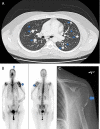TERT Promoter Mutations Are an Independent Predictor of Distant Metastasis in Middle Eastern Papillary Thyroid Microcarcinoma
- PMID: 35360077
- PMCID: PMC8962954
- DOI: 10.3389/fendo.2022.808298
TERT Promoter Mutations Are an Independent Predictor of Distant Metastasis in Middle Eastern Papillary Thyroid Microcarcinoma
Abstract
Background: Papillary thyroid microcarcinomas (PTMCs) have been attributed to the recent increased incidence of thyroid cancer. Although indolent, a subset of PTMC could potentially develop distant metastasis (DM). This study aimed to evaluate the clinico-pathological features and molecular characteristics of PTMC and identify the risk factors for DM in PTMC patients from Middle Eastern ethnicity.
Methods: We retrospectively analyzed 210 patients with histologically confirmed PTMC. Clinico-pathological associations for DM, BRAF mutation and TERT mutation were analyzed successfully in 184 patients. Multivariate analysis was performed using Cox proportional hazards model and logistic regression analysis.
Results: Among the PTMC patients included in this cohort, DM was noted in 6.0% (11/184), whereas tumor relapse occurred in 29/184 (15.8%). Of the 11 cases with DM, lung metastasis occurred in 8 cases, bone metastasis in 2 cases and brain metastasis in 1 case. Presence of extrathyroidal extension and male sex were significantly associated with DM. Molecular analysis showed BRAF V600E mutations to be the most frequent, being detected in 45.7% (84/184). TERT promoter mutations were detected in 16 (8.7%) cases and were significantly associated with DM and shorter metastasis-free survival in multivariate analysis.
Conclusions: Our study indicates a surprisingly high frequency of TERT promoter mutation in Saudi patients with PTMC. Identifying TERT promoter mutations as an independent predictor of DM in patients with microcarcinoma could explain the inherent aggressive nature of PTMC from Middle Eastern ethnicity and magnify its role in patient risk stratification, which might help in improving therapeutic strategy for these patients.
Keywords: TERT promoter mutations; distant metastasis; metastasis-free survival; papillary thyroid microcarcinoma; predictor.
Copyright © 2022 Parvathareddy, Siraj, Iqbal, Qadri, Ahmed, Al-Rasheed, AlQatie, Al-Sobhi, Al-Dayel and Al-Kuraya.
Conflict of interest statement
The authors declare that the research was conducted in the absence of any commercial or financial relationships that could be construed as a potential conflict of interest.
Figures


Similar articles
-
Presence of TERT ± BRAF V600E mutation is not a risk factor for the clinical management of patients with papillary thyroid microcarcinoma.Surgery. 2021 Sep;170(3):743-747. doi: 10.1016/j.surg.2021.03.056. Epub 2021 May 2. Surgery. 2021. PMID: 33952391
-
A Significance of Concomitant BRAFV600E and TERT Mutations in Polish Patients with Papillary Thyroid Microcarcinoma: A Retrospective Cohort Study Based on 430 Cases.Thyroid. 2022 Nov;32(11):1372-1381. doi: 10.1089/thy.2022.0155. Epub 2022 Sep 9. Thyroid. 2022. PMID: 35950639
-
Effects of Coexistent BRAFV600E and TERT Promoter Mutations on Poor Clinical Outcomes in Papillary Thyroid Cancer: A Meta-Analysis.Thyroid. 2017 May;27(5):651-660. doi: 10.1089/thy.2016.0350. Epub 2017 Mar 7. Thyroid. 2017. PMID: 28181854
-
Association of BRAFV600E Mutation with the Aggressive Behavior of Papillary Thyroid Microcarcinoma: A Meta-Analysis of 33 Studies.Int J Mol Sci. 2022 Dec 9;23(24):15626. doi: 10.3390/ijms232415626. Int J Mol Sci. 2022. PMID: 36555268 Free PMC article. Review.
-
BRAF Status in Papillary Microcarcinomas of the Thyroid Gland: a Brief Review.Curr Mol Med. 2019;19(9):665-672. doi: 10.2174/1566524019666190717161359. Curr Mol Med. 2019. PMID: 31625469 Review.
Cited by
-
TERT RNAscope analysis of sub-centimetric papillary thyroid carcinomas and synchronous lymph node metastases.Thyroid Res. 2024 Apr 15;17(1):8. doi: 10.1186/s13044-024-00195-7. Thyroid Res. 2024. PMID: 38616265 Free PMC article.
-
Multi-omics profiling of papillary thyroid microcarcinoma reveals different somatic mutations and a unique transcriptomic signature.J Transl Med. 2023 Mar 20;21(1):206. doi: 10.1186/s12967-023-04045-2. J Transl Med. 2023. PMID: 36941725 Free PMC article.
-
Risk Factors for Cervical Lymph Node Metastasis in Middle Eastern Papillary Thyroid Microcarcinoma.J Clin Med. 2022 Aug 8;11(15):4613. doi: 10.3390/jcm11154613. J Clin Med. 2022. PMID: 35956227 Free PMC article.
-
PLK1 and FoxM1 expressions positively correlate in papillary thyroid carcinoma and their combined inhibition results in synergistic anti-tumor effects.Mol Oncol. 2024 Mar;18(3):691-706. doi: 10.1002/1878-0261.13610. Epub 2024 Feb 15. Mol Oncol. 2024. PMID: 38361222 Free PMC article.
-
Development and validation of an interpretable machine learning model for predicting the risk of distant metastasis in papillary thyroid cancer: a multicenter study.EClinicalMedicine. 2024 Oct 30;77:102913. doi: 10.1016/j.eclinm.2024.102913. eCollection 2024 Nov. EClinicalMedicine. 2024. PMID: 39552714 Free PMC article.
References
MeSH terms
Substances
Supplementary concepts
LinkOut - more resources
Full Text Sources
Medical
Research Materials

